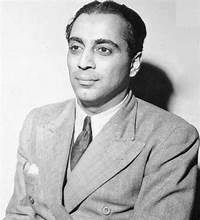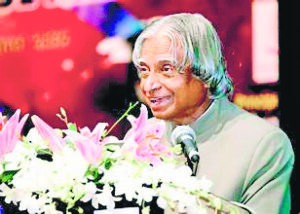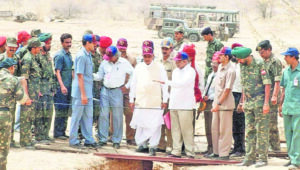
The journey of India’s nuclear energy success has been marked by significant achievements, challenges, and milestones. India has a largely indigenous nuclear power programme. The government is committed to growing its nuclear power capacity as part of its massive infrastructure development programme. It has set ambitious targets to grow nuclear capacity.
Nuclear power is the fifth-largest source of electricity in India after coal, gas, hydroelectricity and wind power. India has been making advances in the field of thorium-based fuels, working to design and develop a prototype for an atomic reactor using thorium and low-enriched uranium, a key part of India’s three stage nuclear power programme.
Here’s an overview of key stages in the evolution of India’s nuclear energy program:
Nascent Stage (1900s).
As early as 1901, the Geological Survey of India (GSI) had recognised India as potentially having significant deposits of radioactive ores, including pitchblende, uranium and thorianite. In the ensuing 50 years, however, little to no effort was made to exploit those resources. During the 1920s and 1930s, Indian scientists maintained close links to their counterparts in Europe and the United States, and were well aware of the latest developments in physics. Several Indian physicists, notably Daulat Singh Kothari, Meghnad Saha, Homi J. Bhabha and R. S. Krishnan, conducted pioneering research in nuclear physics in Europe during the 1930s.
By 1939, Meghnad Saha, the Palit Professor of Physics at the University of Calcutta, had recognised the significance of the discovery of nuclear fission, and had begun to conduct various experiments in his laboratory related to nuclear physics. In 1940, he incorporated nuclear physics into the university’s post-graduate curriculum. In the same year, the Sir Dorabji Tata Trust sanctioned funds for installing a cyclotron at the University of Calcutta, but various difficulties likely related to the war delayed the project.
Foundation and Vision (1940s-1950s):
In 1944, Homi J. Bhabha, a distinguished nuclear physicist who had established a research school at the Indian Institute of Science, Bangalore, wrote a letter to his distant cousin J. R. D. Tata, the chairman of the Tata Group and requested funds to establish a research institute of fundamental physics, “with special reference to cosmic rays and nuclear physics.” The Tata Institute of Fundamental Research (TIFR) was inaugurated in Mumbai the following year.
In March 1946, the Board of Scientific and Industrial Research (BSIR), under the Council of Scientific and Industrial Research (CSIR), set up an Atomic Research Committee under Bhabha’s leadership to explore India’s atomic energy resources and to suggest ways to develop and harness them, along with establishing contacts with similar organisations in other nations.
Early in 1947, plans were made to establish a Uranium Unit under the Geological Survey of India, to focus on identifying and developing resources of uranium-bearing minerals. In June 1947, two months before Indian independence, Chakravarti Rajagopalachari, then Minister for Industry, Supply, Education and Finance in the Interim Government of India, established an advisory board for research in atomic energy.
On 23 March 1948, Prime Minister Jawaharlal Nehru introduced the Atomic Energy Bill in the Indian Parliament, and it was subsequently passed as the Indian Atomic Energy Act. Modelled on the British Atomic Energy Act 1946, the Act granted sweeping powers to the central government over nuclear science and research, including surveying for atomic minerals, the development of such mineral resources on an industrial scale, conducting research regarding the scientific and technical problems connected with developing atomic energy for peaceful purposes, the training and education of the necessary personnel and the fostering of fundamental research in the nuclear sciences in Indian laboratories, institutes and universities. Around the same time, the Government of West Bengal sanctioned the construction of a nuclear physics institute under the University of Calcutta; the cornerstone was laid in May 1948, and the institute was inaugurated on 11 January 1950 by Irène Joliot-Curie.
With effect from 1 June 1948, the advisory board for Research in Atomic Energy, together with its parent organisation the CSIR, was folded into the new Department of Scientific Research and placed directly under the Prime Minister. On 3 August 1948, the Atomic Energy Commission of India (AEC) was established and made separate from the Department of Scientific Research, with Bhabha as its first chairman. In 1949 Tata Institute of Fundamental Research was designated by the CSIR as the hub for all major nuclear science research projects.
Research and Early Reactors (1950s-1960s):
The 1950s saw the establishment of the Bhabha Atomic Research Centre (BARC) in Trombay, which became the focal point for nuclear research in India. In 1950, the government announced it would purchase all available stocks of uranium and beryllium minerals and ores, and declared large rewards for any significant discoveries of the same.
On 3 January 1954, the Atomic Energy Establishment, Trombay (AEET) was established by the Atomic Energy Commission to consolidate all nuclear reactor research and technology-related developments; Later, the Atomic Energy Commission and all its subordinate agencies, including the Tata Institute of Fundamental Research and the nuclear research institute at Calcutta University, were transferred to the new Department of Atomic Energy and placed under the direct charge of the Prime Minister’s Office. In May 1956, construction on a uranium metal plant and a fuel element fabrication facility for the research reactors began at Trombay; the uranium plant came into operation in January 1959, followed by the fuel element facility in February 1960The AEET (renamed the Bhabha Atomic Research Centre in 1967, after Bhabha’s death) was formally inaugurated by Nehru in January 1957. With the expanding scope of Indian nuclear research, the 1948 Atomic Energy Act was amended in 1961, and was passed as the new Atomic Energy Act, coming into force in September 1962. India’s first nuclear reactor, Apsara, became operational in 1956, paving the way for subsequent advancements in reactor technology.
Commercialization with Tarapur (1960s-1970s):
The Tarapur Atomic Power Station (TAPS) started operating in 1969, becoming India’s first commercial nuclear power plant. TAPS was a product of international collaboration, with assistance from the United States. The peaceful nuclear explosion, “Smiling Buddha,” in 1974 marked India’s entry into the group of nuclear-armed nations.
Indigenous Reactor Development (1980s-1990s):
The 1980s and 1990s witnessed the development of indigenous nuclear reactors, particularly Pressurized Heavy Water Reactors (PHWRs). The Kakrapar-1 reactor, operational in 1993, was a significant milestone in the indigenous development of nuclear power technology.
Challenges and Sanctions (1990s):
In the aftermath of the Pokhran-I nuclear tests in 1974, India faced international sanctions, limiting its access to nuclear technology and fuel. The challenges posed by sanctions spurred India to pursue self-reliance and develop indigenous capabilities in nuclear technology.
Nuclear Deal and International Collaboration (2000s):
The U.S.-India Civil Nuclear Agreement, signed in 2005, marked a turning point. It allowed India access to international nuclear technology and fuel, ending decades of isolation.
India engaged in collaborations with various countries for nuclear technology and signed agreements with Russia, France, and others for the construction of nuclear power plants.
Expansion and Diversification (2010s-Present):
India expanded its nuclear energy capacity, commissioning several indigenous reactors and those built in collaboration with other countries. The emphasis on safety and technological advancements continued, with developments in Fast Breeder Reactors (FBRs) and exploration of thorium-based nuclear reactors.
Now, the government of India has planned to add 18 more nuclear reactors to its national energy mix by 2031–32, bringing the total nuclear power capacity of the country to 22.4GW, according to the NPCIL.
The 18 new reactors will collectively generate an additional 13.8GW of electricity. NPCIL currently operates 24 nuclear reactors with a combined capacity of 8.1GW.
The announcement follows the inauguration by India’s Prime Minister Narendra Modi of two 700MW indigenously built reactors at Kakrapar in Gujarat in February 2024. The two new units included the Kakrapar Atomic Power Station (KAPS 3 and 4). Unit 3 has been operational since August 2023. Unit 4 achieved its first criticality in December of the same year and was connected to the western power grid two days before the Prime Minister’s visit.

The commissioning of the two units has brought the facility’s total capacity to 1.8GW. Construction on the units began in 2010. A total of 1.4 million cubic metres of concrete were poured and the structures required 21,000 tonnes of structural steel. The reactors are the largest indigenous pressurised heavy water reactors (PWHRs) in India and feature advanced safety measures.
India’s nuclear power expansion includes four 1GW reactors being built with Russian assistance at Kudankulam in Tamil Nadu, and four 700MW PHWRs under construction at Rawatbhata in Rajasthan and Gorakhpur in Haryana.
Ten more 700MW PHWRs have also been sanctioned across locations including Gorakhpur and Kaiga in Karnataka, Chutka in Madhya Pradesh and Mahi Banswara in Rajasthan.
India is seeking Rs2.16trn in private investment for its nuclear energy industry as it looks to decarbonise its power sector. It is in talks with at least five private companies including Reliance Industries, Tata Power, Adani Power and Vedanta to invest Rs440bn each.
Balancing Energy Needs and Non-Proliferation Commitments:
India continues to navigate the delicate balance between meeting its growing energy demands and upholding its commitments to non-proliferation.
The country is actively involved in international forums to promote peaceful uses of nuclear energy and strengthen global non-proliferation efforts.
Protests
Following the 2011 Fukushima nuclear disaster there have been numerous anti-nuclear protests at proposed nuclear power plant sites. There have been mass protests against the Jaitapur Nuclear Power Project in Maharashtra and the Kudankulam Nuclear Power Plant in Tamil Nadu, and a proposed large nuclear power plant near Haripur was refused permission by the Government of West Bengal. A Public Interest Litigation (PIL) has also been filed against the government’s civil nuclear programme at the Supreme Court.
Martial Power
India is recognized as a nuclear-armed state. India conducted its first successful nuclear tests in 1974, establishing itself as a country possessing nuclear weapons. Later, in 1998, India conducted a series of nuclear tests at Pokhran under the government of then prime minister Atal Bihari Vajpayee. The tests included both fission and thermonuclear devices, further solidifying its nuclear capabilities. These tests were collectively referred to as “Pokhran-II.”
India’s nuclear doctrine is based on a policy of no-first-use (NFU), meaning that it commits to using nuclear weapons only in response to a nuclear attack on its territory. The doctrine also emphasizes a credible minimum deterrent posture. This approach aims to ensure the security of the nation while signaling a commitment to global nuclear disarmament.
India’s possession of nuclear weapons is primarily seen as a deterrent against potential adversaries. The nuclear capability is intended to dissuade other nations from initiating nuclear aggression against India. The country has developed a range of delivery systems for its nuclear weapons, including ballistic missiles, cruise missiles, and strategic bombers. The country has a dedicated Strategic Forces Command responsible for the management and deployment of its nuclear arsenal.
It is also working towards achieving a credible nuclear triad, which includes land-based missiles, sea-based (submarine-launched) missiles, and air-based delivery systems. This triad capability enhances the survivability and effectiveness of its nuclear deterrent. India’s nuclear status has implications for its international relations, especially with regard to its relationships with other nuclear-armed states. India seeks to engage with the global non-proliferation community while maintaining its independent nuclear policy. The country has taken steps to secure its nuclear materials and facilities and has expressed its commitment to responsible nuclear behavior.
Role of Dr. A.P.J. Abdul Kalam Azad in Indian Nuclear program

Dr. A.P.J. Abdul Kalam Azad played a significant role in the Indian nuclear program, particularly in the development of missile technology. His contributions were instrumental in shaping India’s defense capabilities. Here are some key aspects of his role in the Indian nuclear program:
Missile Development:
Dr. Kalam joined the Defense Research and Development Organisation (DRDO) in 1958 and later became the director of the Integrated Guided Missile Development Program (IGMDP).
He led the successful development of various missile systems, including the Agni series, Prithvi, Akash, and Nag missiles. These missiles have both strategic and tactical applications, enhancing India’s defense capabilities. Dr. A.P.J. Abdul Kalam Azad’s contributions to the Indian nuclear program were characterized by his commitment to technological excellence, self-reliance, and the strategic integration of defense capabilities. His legacy continues to influence India’s defense and scientific communities.

Critical Role in Pokhran-II:
Dr. Kalam played a key role in the Pokhran-II nuclear tests conducted in 1998. As the Chief Project Coordinator, he was responsible for overseeing the scientific and technical aspects of the tests. The successful tests established India as a nuclear weapons state, and Dr. Kalam’s leadership was crucial in ensuring the scientific success of the mission.
Advocacy for Technological Self-Reliance:
Dr. Kalam strongly believed in technological self-reliance and advocated for the indigenous development of defense capabilities. Under his leadership, DRDO made strides in developing cutting-edge technologies, reducing dependence on foreign sources for critical defense systems.
Strategic Vision and Integration:
Dr. Kalam was known for his strategic vision and ability to integrate various scientific and technological elements into a cohesive defense strategy. He emphasized the importance of a strong defense infrastructure to ensure the security and sovereignty of the nation.
Leadership at DRDO:
Dr. Kalam served as the Chief Scientific Adviser to the Prime Minister and the Secretary of the DRDO from 1992 to 1999. His leadership during this period played a crucial role in advancing India’s missile and defense capabilities.
Integration of Civilian and Military Technologies:
Dr. Kalam worked towards the integration of civilian and military technologies, recognizing the dual-use potential of many scientific advancements. His efforts contributed to the development of technologies that found applications not only in defense but also in areas like space exploration and telecommunications.